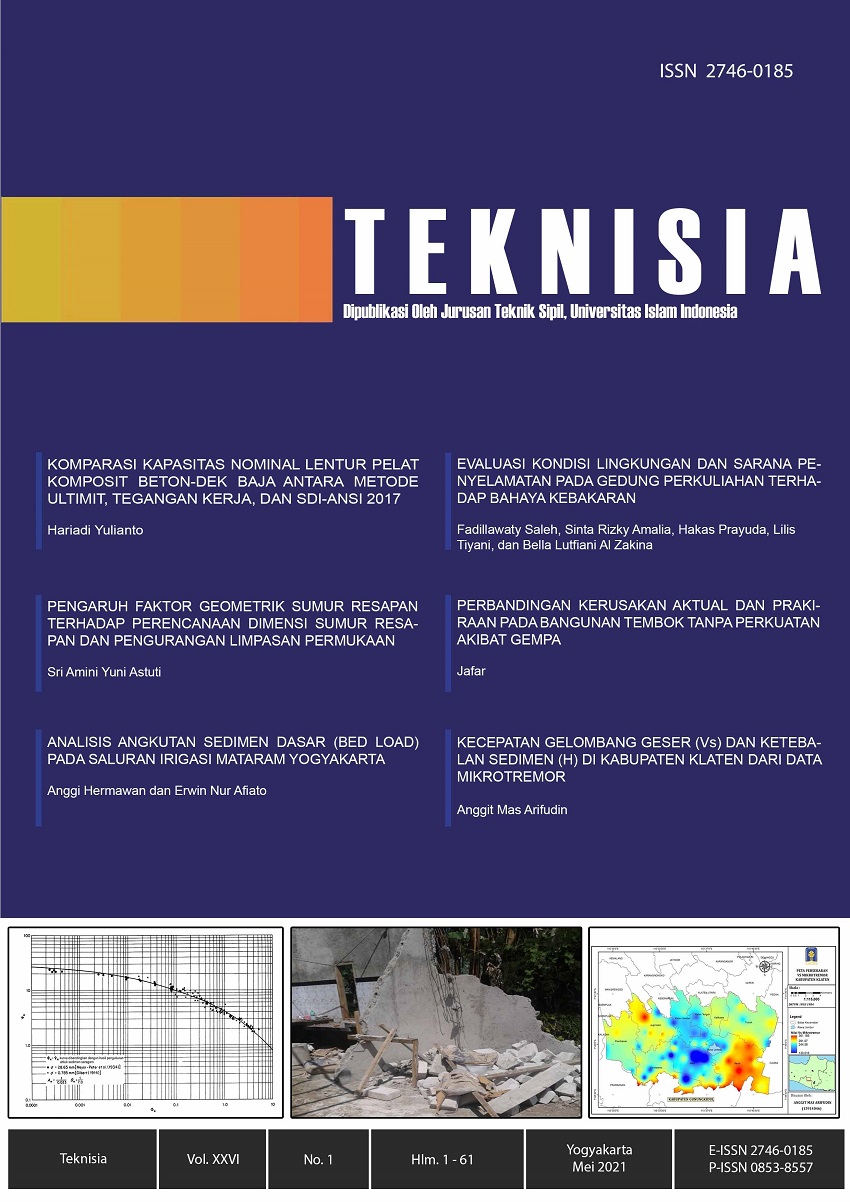Main Article Content
Abstract
Keywords
Article Details
Under the following term:
-
Attribution — You must give appropriate credit, provide a link to the license, and indicate if changes were made. You may do so in any reasonable manner, but not in any way that suggests the licensor endorses you or your use.
-
ShareAlike — If you remix, transform, or build upon the material, you must distribute your contributions under the same license as the original.
- No additional restrictions — You may not apply legal terms or technological measures that legally restrict others from doing anything the license permits.
References
- Afiato, E.N. (2016). “Distribusi Kecepatan Aliran dan Konsentrasi Sedimen Suspensi pada Aliran Tidak Seragam (Studi Kasus Saluran Mataram Yogyakarta)”. Tesis. Universitas Gadjah Mada.
- Balai Besar Wilayah Sungai Serayu Opak. (2016). “Peta Daerah Irigasi Mataram Van Der Weich”. Kementerian Pekerjaan Umum. Jakarta.
- Carter, D.L. dan Agricultural Research Service, U. S. Department of Aviculture. (1976). “Guidelines for Sediment Control in Irrigation Return Flow”. Journal of Environmental Quality, Vol. 5, No. 2.
- Darly, B., Simons, et al. (2004). “Geomorphic, Hydrologic, Hydraulic and Sediment Concepts Applied To Alluvial Rivers”. Colorado State University. Colorado.
- Einstein, H.A. (1950). “The Bed Load Function for Sediment Transportation in Open Channel Flows”. USDA Soil Conservation Service. Washington DC.
- Hassanzadeh, Y. (2012). “Hydraulics of Sediment Transport”. In Tech Publisher. Tabriz Iran.
- Istiarto. (2014). “Bed Load Transport Sediment”. Bahan Kuliah Magister Teknik Pengelolaan Bencana Alam UGM. Yogyakarta.
- Istiarto. (2014). “Awal Gerak Butir Sedimen”. Bahan Kuliah Magister Teknik Pengelolaan Bencana Alam UGM. Yogyakarta.
- Kironoto, B. A. (2007). “Pengaruh Angkutan Sedimen Dasar (Bed Load) Terhadap Distribusi Kecepatan Gesek Arah Transversal Pada Aliran Seragam Saluran Terbuka”. Jurnal Teknik Sipil dan Lingkungan, Vol. 17, No. 2, pp. 566-579.
- Meyer-Peter, E., dan Muller, R. (1948). “Formula for Bed-Load Transport”. IAHSR. Stockholm.
- Maini, M. (2016). “Distribusi Konsentrasi Sedimen Suspensi pada Belokan Saluran Terbuka Tampang Trapesium (Studi Kasus Saluran Mataram Yogyakarta)”. Tesis. Universitas Gadjah Mada.
- Putra, I. B. G. et al. (2016). “Analisis Sedimentasi pada Saluran Utama Bendung Jangkok”. Jurnal Spektrum Sipil, Vol. 3, No. 2. pp. 208-214.
- Suparman. (2011). “Sabo Untuk Penanggulangan Bencana Akibat Aliran Sedimen”. Yayasan Air Adhi Eka & JICA (Japan International Coorporation Agency). Jakarta.
- Suryawan, W.A. (2008). “Kajian Angkutan Sedimen Dasar pada Saluran dengan Material Dasar Tidak Seragam”. Tesis. Universitas Gadjah Mada.
- Trimble, S. W. (1997). “Contribution Contribution of Stream Channel Erosion to Sediment Yield from an Urbanizing Watershed”. Journal Science, Vol. 278.
References
Afiato, E.N. (2016). “Distribusi Kecepatan Aliran dan Konsentrasi Sedimen Suspensi pada Aliran Tidak Seragam (Studi Kasus Saluran Mataram Yogyakarta)”. Tesis. Universitas Gadjah Mada.
Balai Besar Wilayah Sungai Serayu Opak. (2016). “Peta Daerah Irigasi Mataram Van Der Weich”. Kementerian Pekerjaan Umum. Jakarta.
Carter, D.L. dan Agricultural Research Service, U. S. Department of Aviculture. (1976). “Guidelines for Sediment Control in Irrigation Return Flow”. Journal of Environmental Quality, Vol. 5, No. 2.
Darly, B., Simons, et al. (2004). “Geomorphic, Hydrologic, Hydraulic and Sediment Concepts Applied To Alluvial Rivers”. Colorado State University. Colorado.
Einstein, H.A. (1950). “The Bed Load Function for Sediment Transportation in Open Channel Flows”. USDA Soil Conservation Service. Washington DC.
Hassanzadeh, Y. (2012). “Hydraulics of Sediment Transport”. In Tech Publisher. Tabriz Iran.
Istiarto. (2014). “Bed Load Transport Sediment”. Bahan Kuliah Magister Teknik Pengelolaan Bencana Alam UGM. Yogyakarta.
Istiarto. (2014). “Awal Gerak Butir Sedimen”. Bahan Kuliah Magister Teknik Pengelolaan Bencana Alam UGM. Yogyakarta.
Kironoto, B. A. (2007). “Pengaruh Angkutan Sedimen Dasar (Bed Load) Terhadap Distribusi Kecepatan Gesek Arah Transversal Pada Aliran Seragam Saluran Terbuka”. Jurnal Teknik Sipil dan Lingkungan, Vol. 17, No. 2, pp. 566-579.
Meyer-Peter, E., dan Muller, R. (1948). “Formula for Bed-Load Transport”. IAHSR. Stockholm.
Maini, M. (2016). “Distribusi Konsentrasi Sedimen Suspensi pada Belokan Saluran Terbuka Tampang Trapesium (Studi Kasus Saluran Mataram Yogyakarta)”. Tesis. Universitas Gadjah Mada.
Putra, I. B. G. et al. (2016). “Analisis Sedimentasi pada Saluran Utama Bendung Jangkok”. Jurnal Spektrum Sipil, Vol. 3, No. 2. pp. 208-214.
Suparman. (2011). “Sabo Untuk Penanggulangan Bencana Akibat Aliran Sedimen”. Yayasan Air Adhi Eka & JICA (Japan International Coorporation Agency). Jakarta.
Suryawan, W.A. (2008). “Kajian Angkutan Sedimen Dasar pada Saluran dengan Material Dasar Tidak Seragam”. Tesis. Universitas Gadjah Mada.
Trimble, S. W. (1997). “Contribution Contribution of Stream Channel Erosion to Sediment Yield from an Urbanizing Watershed”. Journal Science, Vol. 278.
